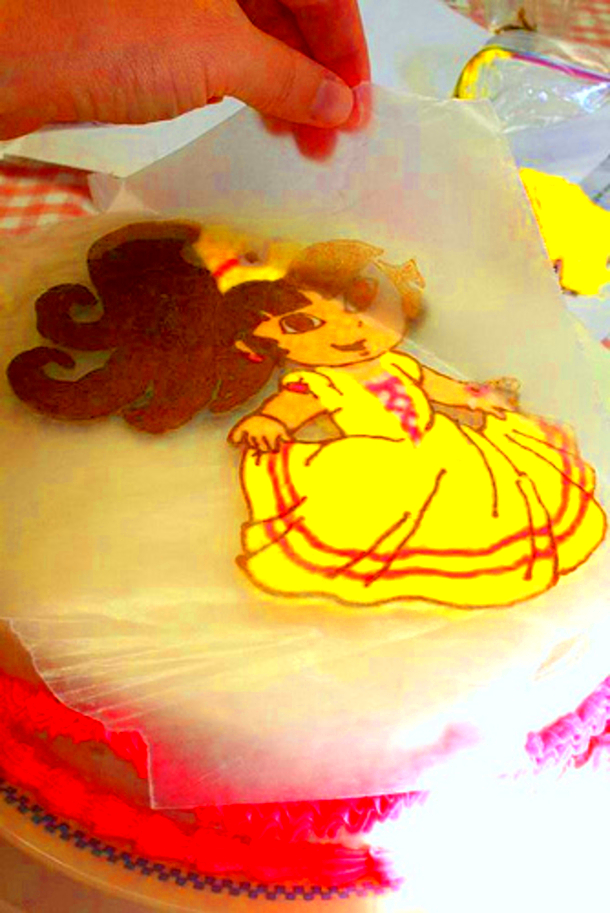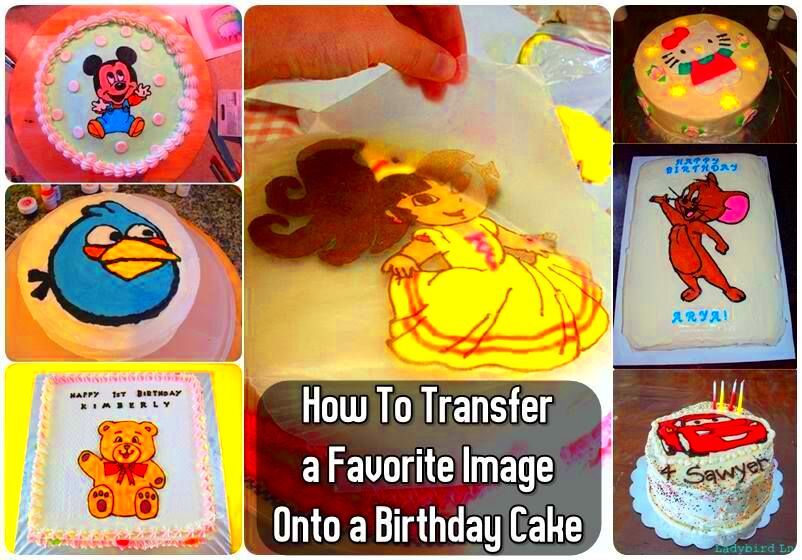A transformation has been observed in cake decoration arena from long time ago, and one of its most thrilling methods is transferring images onto cakes; bakers are now able to imbue individuality into their creations which makes them unforgettable during special events. Not only does this practice allow for greater visual appeal for any type of occasion such as birthdays, weddings etc., but also it could be considered as a form of art.
Any adaptation of any design can be made real through image switch. Below are some of the few examples that show its importance:
- Personalization: Custom images make cakes feel special and unique.
- Professional Look: Transfers can give a polished and professional appearance.
- Versatility: You can use photographs, logos, or any graphic design.
- Creativity: This technique allows you to explore your artistic side and create stunning designs.
Choosing the Right Images for Your Cake

Choosing the appropriate visuals is vital for effective cake designing. These are a few suggestions that can guide your selection:
- Quality of Image: Use high-resolution images. Blurry images can ruin the final look.
- Theme Match: Select images that fit the occasion. A wedding cake might need elegant designs, while a birthday cake can be playful.
- Color Scheme: Consider how the colors in the image will blend with the cake's frosting and decorations.
- Size of Image: Ensure the image fits well on the cake. You don’t want it to be too big or too small.
After an image is selected it should be put through some tests. Print it out and check what changes might be necessary before transferring it unto the cake.
Also Read This: Simple Steps to Let You Learn How to Download a Video from Facebook Story
Preparing the Cake Surface for Image Transfer
To be able to transfer an image properly, you must first make the cake surface ready correctly. A smooth and uniform surface guarantees that the image sticks nicely and appears attractive. Here is a method for preparing your cake:
- Cooling the Cake: Always let your cake cool completely. A warm cake can distort the image.
- Applying a Base Layer: Use a thin layer of frosting to create a smooth base. This layer will help the image stick better.
- Smoothing the Surface: Use a spatula or a cake smoother to ensure the frosting is even. Pay attention to the edges.
- Chilling the Cake: After frosting, chill the cake for about 30 minutes. This will help the frosting set and make it easier to transfer the image.
In fact, there is always someone who can help with cake preparation, as it is possible to hire people or even ask friends when the time comes. This will give one the needed courage to imagine working on his or her own cake once again with less anxiety.
Also Read This: Editing Dailymotion Videos in iMovie – A Step-by-Step Guide
Selecting the Best Method for Transferring Images
When it involves moving photographs to pastries, a lot of options are available. Each technique has certain benefits, thus making it suitable for various tastes and the category of picture in use. This paper investigates a few well-known approaches:
- Edible Paper Transfers: This method uses specially designed edible papers that allow you to print images with edible ink. It’s great for detailed images and photographs.
- Buttercream Transfer: This technique involves piping the image onto a piece of parchment paper. Once it’s set, you can flip it onto the cake. It’s perfect for creating custom designs.
- Royal Icing Transfers: If you’re looking for a method that holds its shape well, royal icing transfers are ideal. You can create intricate designs and store them for later use.
- Direct Printing: Some advanced cake decorators use printers that print directly onto cakes using food-safe inks. This method provides the best quality but requires specific equipment.
This selection's appropriateness relies on your personal ease, the resources at hand and how intricate or simple should the layout turn out. Nevertheless, practise leads to proficiency therefore do not hesitate to experiment with diverse methods!
Also Read This: Can I Edit a LinkedIn Post? A Comprehensive Guide to Editing Your Posts
Using Edible Paper and Ink for Image Transfer
The most popular method for transferring images onto cakes is by using edible paper and ink. It is an easy and efficient technique that makes it possible to recreate any of your preferred designs. If you want to know what you need and how to do it, check out the following paragraphs:
- Types of Edible Paper:
- Wafer Paper: Lightweight and perfect for delicate designs.
- Frosting Sheets: Thicker and more flexible, ideal for vibrant images.
- Edible Ink: Make sure to use food-safe ink specifically designed for printing on edible paper. This ink comes in cartridges for various printers.
- Printer: A standard inkjet printer can be used, but ensure it’s dedicated for edible printing to avoid contamination.
To transport one image, just print your design on the edible paper, allow to dry and apply on to your prepared cake surface. For more effective results, ensure that the cake is chilled since esto ayudará a que el papel se adhiera mejor.
Also Read This: Exciting Job Opportunities in Image Processing Across the USA
Techniques for Applying Images to Cakes
Using pictures to decorate cakes can be a fun and fulfilling activity. When done correctly, the results will blow everyone away. Below are some common techniques to think about:
- Peeling and Positioning: Once your image is printed on edible paper, carefully peel it off. Position it gently on the cake, making sure it’s centered and aligned.
- Using a Brush: For a more seamless look, use a clean brush to smooth the image onto the cake, pressing lightly to remove any air bubbles.
- Applying Moisture: Lightly mist the cake with water before placing the image on top. This helps the image stick better and creates a smooth finish.
- Finishing Touches: After applying the image, you might want to add borders or additional decorations to enhance the overall look of the cake. Using piping gel or extra frosting can help blend the image into the cake.
Keep it in mind that practicing is important! The more you use these techniques, the more relaxed and expert you will be. Before long, your cakes will be so amazing they will look and taste great!
Also Read This: A Step-by-Step Guide on How to Post a Video on 9GAG
Common Mistakes to Avoid When Transferring Images
Transferring images to cakes is not easy, mainly for the novices. There are a few mistakes which if done may spoil the final appearance of the cake. Below are some of these common mistakes:
- Using Low-Quality Images: Always opt for high-resolution images. Low-quality images can result in blurry or pixelated designs.
- Not Chilling the Cake: Failing to chill the cake before applying the image can lead to smudging and sliding. A cool surface helps the image stick better.
- Skipping the Test Print: Always do a test print of your image on regular paper. This helps you gauge the size and layout before using edible paper.
- Neglecting the Base Layer: Forgetting to apply a base layer of frosting can cause the image to not adhere properly. Always smooth out your frosting before transferring.
- Rushing the Process: Take your time! Rushing can lead to mistakes, such as misalignment or damaging the image while applying it.
By knowing these things that people often do wrong, you can prepare yourself for victory and make stunningly designed pastries easily!
Also Read This: How to Get Signature Collection on iStock: Everything You Need to Know
Frequently Asked Questions About Image Transfer for Cake Decorating
This question pertains to how one can exchange images with their cake. Many individuals, particularly newbies in cake decorating, often wonder about these issues. The following are a few of the most commonly asked questions together with possible solutions:
- Can I use any printer for edible printing?
You should use a dedicated printer for edible ink to avoid contamination. Standard inkjet printers can be converted, but it's best to use a printer meant for food-safe products. - How long does an edible image last on a cake?
Edible images can last up to a week if stored properly, but it’s best to consume the cake within a few days for optimal freshness. - What should I do if my image is too big for the cake?
You can resize the image using photo editing software or crop it carefully to fit the cake. - Can I freeze a cake with an edible image on it?
Freezing is possible, but it’s best to freeze the cake before applying the image. If the cake is frozen with the image, condensation can occur when thawing.
You will find these responses useful as a guide in order to make your cake decorating experience easy!
Conclusion on Transferring Images for Cake Decorating
One of the most thrilling aspects of customizing your cakes is by transferring images onto them. With a little practice and enough tools, it’s possible to create eye-catching designs that would leave your friends and family speechless. Just make sure to select quality images, work on a smooth cake surface as well as avoid some of the common blunders.
Feel free to be imaginative while playing around with different methods. There is a tale that every single cake communicates through its structure. You will become a master of this art and eventually design marvelous cakes which are equally delicious with time and practice.
Then, take your consumed sheets, let inspiration flow and make cakes of a lifetime!

 admin
admin








